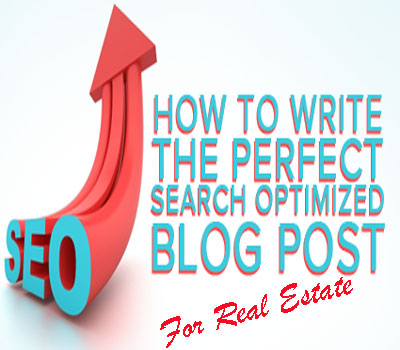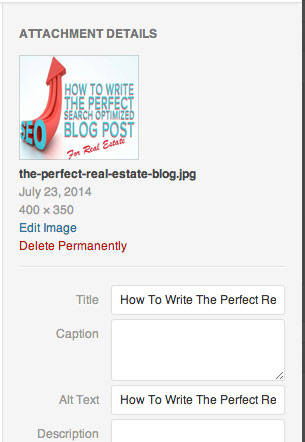You are viewing our site as an Agent, Switch Your View:
Agent | Broker Reset Filters to Default Back to ListAnatomy of the Perfect Real Estate Blog Post
September 11 2014
 Lately, we've been speaking with more and more clients and prospective clients about the intricacies of inbound marketing for real estate.
Lately, we've been speaking with more and more clients and prospective clients about the intricacies of inbound marketing for real estate.
When discussing these concepts and best practices, blogging, of course, comes into the conversation. Aside from the obvious "I don't want to blog!" objections we get from Realtors®, the surprising thing we are finding is that many agents have no real ideas as to what the best practices are for blogging and what steps to take in order to create the perfect, optimized real estate blog post.
Because of this, today I'll break down for you the anatomy of the perfect real estate blog post.
Before You Start, Remember Your Ideal Clients
I've blogged about client personas many, many times. The reason I keep touching on client personas is that they are critical in every way to the success of your marketing efforts. This has never been more important than in your inbound marketing efforts.
You need to know who your ideal clients are, what their interests are, what life stages they are in, and how you can appeal to those things. If you do not know these things, what you write will not appeal to them, they will not be typing long tail searches into sites like Google, and you will never show up in their search results. This is the WORST CASE scenario. Not only are you not getting seen by your ideal clients, but you are also wasting tons of time writing about stuff that nobody is ever going to look at.
Use those client personas to pinpoint the topics you are going to write about and the keywords you want to rank for in the organic searching your ideal clients are going to be doing on the web.
How Long Should My Blog Posts Be?
When writing blog posts, the idea is to create as much content as possible. The more blog posts you have, the better off you are going to be with your organic search rankings. That said, you can't crank out tons of 20 word blog posts and expect to make any headway.
When writing your blog posts, the ideal sweet spot is somewhere around 600 words. As best as we can figure (being that nobody really knows the secret sauce), Google considers 200 words or less as "thin content." That means they will consider your page as infringing on their algorithms and this will not help your cause.
If you consider that nobody really knows the true ins and outs of Google's policies, and also taking into account that you want to have enough content to properly explain your point and be considered quality content by your readers, 600 words is pretty much the sweet spot we've found that will cover all bases.
If you are writing about something very complex and you think it's going to take 1,000, 1,500 or even 2,000 words, break your article into multiple parts. This will keep the attention span of your readers, and give you a greater amount of content that can be indexed by search engines.
SEO TIPS FOR YOUR POSTS
1) It's all in the title
You should only ever spend about an hour to an hour and a half per blog post. During this time, the most important thing you should focus on and possibly devote the most amount of time to is your article's title.

Most search engines use a maximum of 60 characters when showing a blog title, so you should figure out a way to make a compelling title within 60 characters to grab your ideal client's attention.
2) Use at least one compelling photo, and be sure to put alt tags and descriptions in it
 As you can see in the image to the left, this is the attachment details window from my blog's CMS that shows the image that is used at the top of this post.
As you can see in the image to the left, this is the attachment details window from my blog's CMS that shows the image that is used at the top of this post.
In this example, I used a description that covers what this blog post is going to be about.
This is very important as search engines cannot tell what a graphic is without an alt text description. Even more, if your alt description is a brief sentence that is a summary of what your article is all about, you'll have one more thing on the internet that gets indexed and may trigger organic results for a phrase your ideal clients might be typing into a search engine.
Technically, this is not what the alt text area is meant for, but this is a great way to game the system and get a little extra SEO juice in your real estate blog post.
3) Remember to use the keywords you want to rank for naturally throughout your blog post
When you defined your ideal client personas, you also worked on keywords you thought they were most likely going to type into search engines to find you and those became the basis of the subject matter you decided to write about. So as you are writing your articles, be sure to NATURALLY use those keywords or phrases in your posts.
For instance, if you look at this article, you'll see I am doing exactly this, in relation to "real estate blog posts" and the best practices to put ideal posts together.
4) Don't forget your Excerpt Description and Tags!
Lastly, when you are all done with your post, you never want to forget to put your description and your tags into the post.

Your description is the caption that is going to show up in search results. Most web browsers have a maximum of 160 characters in the description, so you'll want to try to fit it exactly to that number of characters, ensuring the excerpt of your blog post is easy for homeowners to read fully and understand.
Lastly, you'll want to put keywords into the post as well. Keywords or tags MUST be related to the content in the post. If you load your post with keywords that do not relate to your post, search engines will punish you and bury your post where nobody will ever find it.
So there you have it. If you follow these simple steps, your real estate blog is going to be read by tons of prospective clients and homeowners. The best part though is it won't be just "any prospect," but your best case scenario prospects. That is the key to any inbound marketing initiative.
To view the original article, visit the Leading Agent blog.









